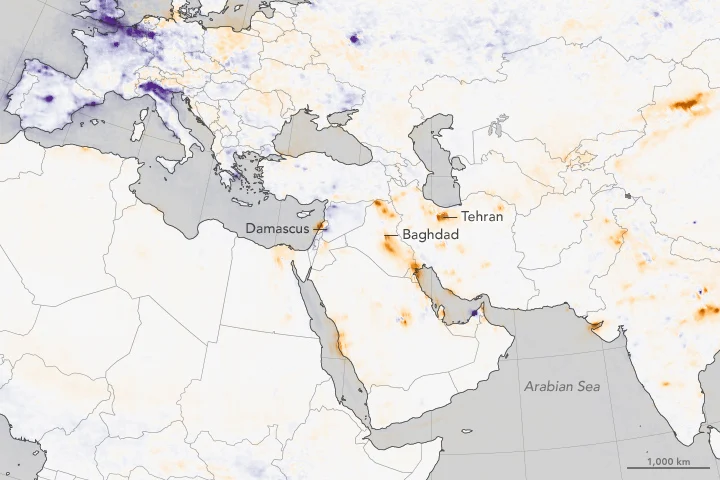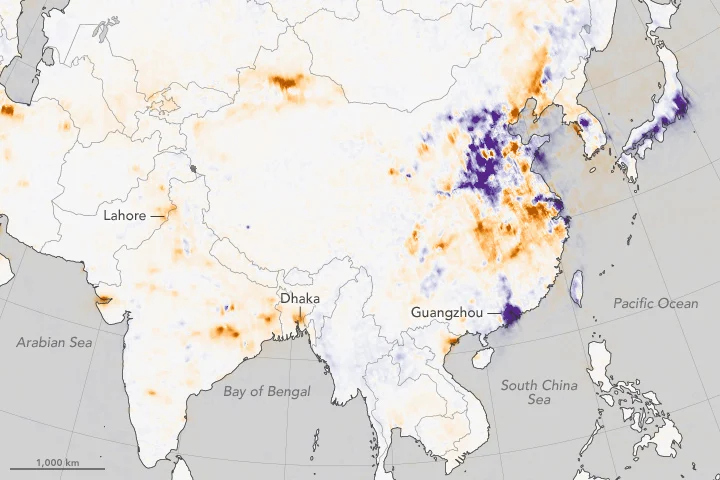In urban areas of the United States, levels of NO2 fell, mainly because of environmental regulations that reduced emissions from motor vehicles and power plants. Declines are most evident in the eastern United States, though densely populated western cities such as Los Angeles (56 percent), Phoenix (54 percent), Atlanta (48 percent), New York (45 percent) also saw levels drop significantly. NO2 concentrations increased slightly in the Williston Basin (North Dakota), the Permian Basin (west Texas), and the Eagle Ford Shale (southern Texas)—areas where natural gas and oil production has increased dramatically due to horizontal drilling and high-volume hydraulic fracturing.
Aura observed declining NO2 levels over most European cities, likely due to the tightening of vehicle emission standards. The cites in Europe that experienced the largest decreases were Madrid (48 percent), Lisbon (47 percent), and Barcelona (44 percent).
The story in the Middle East was mixed. In Iraq, NO2 levels rose 67 percent in Baghdad, 44 percent in Mosul, and 59 percent in Kirkuk. In Iran, Tehran saw levels rise 25 percent. In contrast, the pollutant decreased significantly in Syria, a country that has been plagued by war since 2011. Nitrogen dioxide has dropped 37 percent in Damascus and 40 percent in Aleppo.
In China, levels of nitrogen dioxide rose sharply over some cities and dropped over others. Cities in the North Central Plain saw the biggest increases; meanwhile, nitrogen dioxide was down in Shanghai (30 percent), Hong Kong (28 percent), Quangzhou (43 percent), and even Beijing (10 percent) due to environmental regulations. Beijing’s 10 percent decrease is particularly remarkable given the extent of urbanization that has occurred in recent years, note Duncan and his coauthors.Meanwhile, rising levels of nitrogen dioxide were observed in many cities in India. Chennai, Bengaluru, and Kolkata all saw increases of 20 percent or more. In Pakistan, levels of the pollutant went up 52 percent in Lahore and 46 percent in Islamabad. In Dhaka, the capital city of Bangladesh, NO2 increased by 79 percent, more than any other city in the world.
Via earthobservatory.nasa.gov
Aura observed declining NO2 levels over most European cities, likely due to the tightening of vehicle emission standards. The cites in Europe that experienced the largest decreases were Madrid (48 percent), Lisbon (47 percent), and Barcelona (44 percent).
The story in the Middle East was mixed. In Iraq, NO2 levels rose 67 percent in Baghdad, 44 percent in Mosul, and 59 percent in Kirkuk. In Iran, Tehran saw levels rise 25 percent. In contrast, the pollutant decreased significantly in Syria, a country that has been plagued by war since 2011. Nitrogen dioxide has dropped 37 percent in Damascus and 40 percent in Aleppo.
In China, levels of nitrogen dioxide rose sharply over some cities and dropped over others. Cities in the North Central Plain saw the biggest increases; meanwhile, nitrogen dioxide was down in Shanghai (30 percent), Hong Kong (28 percent), Quangzhou (43 percent), and even Beijing (10 percent) due to environmental regulations. Beijing’s 10 percent decrease is particularly remarkable given the extent of urbanization that has occurred in recent years, note Duncan and his coauthors.Meanwhile, rising levels of nitrogen dioxide were observed in many cities in India. Chennai, Bengaluru, and Kolkata all saw increases of 20 percent or more. In Pakistan, levels of the pollutant went up 52 percent in Lahore and 46 percent in Islamabad. In Dhaka, the capital city of Bangladesh, NO2 increased by 79 percent, more than any other city in the world.
Via earthobservatory.nasa.gov



This post may contain affiliate links. As an Amazon Associate, I earn from qualifying purchases.
Comments
Post a Comment